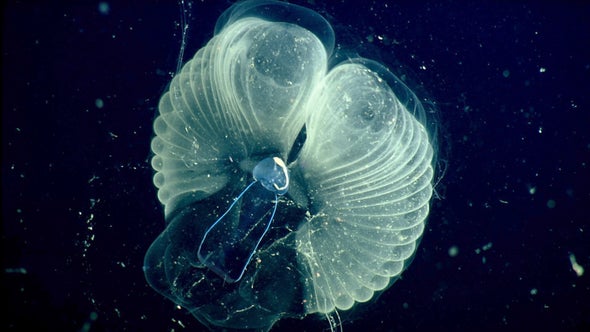(单词翻译:单击)
听力文本
This is Scientific American's 60-second Science, I'm Christopher Intagliata.
Mucus is a miraculous substance. It's in our noses, of course—but it also helps us swallow. And it lubricates our eyes, so we can blink. But it's not just us. Mucus is ubiquitous in the oceans, too.
"Fish are covered in mucus. There are parrot fish that excrete mucus balloons around their head, presumably to protect them against predators or parasites."
Kakani Katija, a bioengineer at the Monterey Bay Aquarium Research Institute. She's interested in the mucus creations of another creature called a larvacean.
"Actually I wonder if I have one in my bag now."
She means a 3-D printed one, not a real one.
Katija says that larvaceans look a lot like tadpoles—and even the ones called "giant" larvaceans are only about four inches long. But they excrete spectacular mucus structures around them—shaped almost like a neck pillow you'd bring on a plane but with ridges and baffles running through them. These "snot palaces," as some people actually call them, help the animals filter ocean waters for food.

Katija's team sent a robot diving in California's Monterey Bay to observe those mucus mansions, as nobody appears to call them, in greater detail than ever before by shooting laser light at the larvaceans. Those expeditions have allowed the researchers to create 3-D models—which means you'll soon be able to 3-D print your own larvacean, too, if you like. And they plugged the models into a virtual reality environment...
"So that somebody can walk inside and through these filters."
The details and lots of images are in the journal Nature.
One application of the analysis is that engineers might someday derive inspiration from the mucus structures to design more efficient filters. But there's also an element of wonder to the work as well.
"I'm just really excited that we finally have the capability to observe mucus in all these different forms in the deep sea."
Thanks for listening for Scientific American's 60-second Science. I'm Christopher Intagliata.
参考译文
这里是科学美国人——60秒科学系列,我是克里斯托弗·因塔格里塔。
黏液是种神奇的物质。当然,我们的鼻子里就有黏液,它也能帮助我们吞咽。黏液润滑我们的眼睛,所以我们可以眨眼。但不仅人类有黏液。它在海洋中也无处不在。
“鱼类身上布满黏液。比如,鹦鹉鱼的头部会分泌出黏液气球,这大概是为了保护它们免受捕食者或寄生虫的攻击。”
蒙特利湾水族馆研究所的生物工程师卡卡尼·卡迪加说到。她感兴趣的是名为幼形虫的另一种生物的黏液。
“事实上,我想知道现在我的包里是不是就有一只。”
她指的是3D打印的虫子,可不是真的虫子。
卡迪加表示,幼形虫看起来很像蝌蚪,甚至那些被称为“巨型”幼形虫的虫子也只有约4英寸长。但它们周身分泌出惊人的黏液结构,形似你带上飞机的那种颈枕,但带有隆起,而且隔板贯穿其中。这些“鼻涕宫殿”——有些人真的这样叫它——帮助它们过滤海水以获取食物。
卡迪加的团队派机器人潜入加利福尼亚州蒙特利湾,通过向幼形虫发射激光,比以往仔细得多地观察这些“黏液宅邸”(似乎并没有人这样称呼它们)。这些探险活动使研究人员能够创造出3D模型,这意味着如果你愿意,你也能很快打印出自已的幼形虫3D模型。他们将这些模型接入虚拟现实环境中。
“这样就有人可以走进并通过这些过滤器。”
研究细节以及大量图片刊登在《自然》期刊上。
这种分析的应用之一是,工程师有朝一日能从黏液结构中获得灵感,设计出更高效的过滤器。但这项工作也有奇迹因素。
“我真的很兴奋,因为我们终于有能力在深海观察到各种不同形式的黏液了。”
谢谢大家收听科学美国人——60秒科学。我是克里斯托弗·因塔利亚塔。
译文为可可英语翻译,未经授权请勿转载!
重点讲解
重点讲解:
1. be interested in 感兴趣的;有兴趣的;关心的;
He was interested in all aspects of the work here.
他对这里工作的所有方面都感兴趣。
2. allow sb. to do sth. 允许;容许;准许;
The course allows students to progress at their own speed.
本课程允许学生按各自的速度学习。
3. if you like (用于非正式地提出或同意建议)如果你乐意的话;
You can stay here if you like.
如果你愿意,可以呆在这里。
4. derive sth. from... 获得;取得;得到;
Mr Ying is one of those happy people who derive pleasure from helping others.
英先生属于那种助人为乐的快活人。


